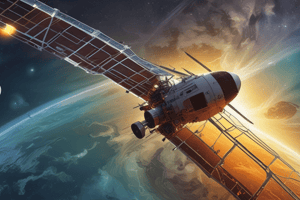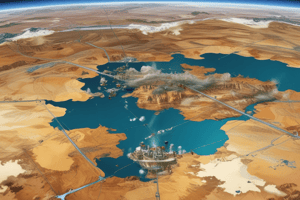Podcast
Questions and Answers
What is a primary function of satellite technology?
What is a primary function of satellite technology?
- Deep space exploration
- Rocket launching
- Weather monitoring (correct)
- Human transportation
Which category of launch vehicles is designed to be used only once?
Which category of launch vehicles is designed to be used only once?
- Vertical launch vehicles (VLVs)
- Expendable launch vehicles (ELVs) (correct)
- Reusable launch vehicles (RLVs)
- Recycled launch vehicles (ReLVs)
Which type of spacecraft is designed for travel or operation in outer space without human presence?
Which type of spacecraft is designed for travel or operation in outer space without human presence?
- Space stations
- Crewed spacecraft
- Manned missions
- Rovers (correct)
What is one example of robotics and automation in space?
What is one example of robotics and automation in space?
Which propulsion system primarily relies on chemical reactions to generate thrust?
Which propulsion system primarily relies on chemical reactions to generate thrust?
What is a challenge in space technology related to sustainability?
What is a challenge in space technology related to sustainability?
What advancement has allowed private companies to increase their participation in space missions?
What advancement has allowed private companies to increase their participation in space missions?
What is a recent trend in satellite technology development?
What is a recent trend in satellite technology development?
What type of exploration technology is designed for analyzing and collecting samples from celestial bodies?
What type of exploration technology is designed for analyzing and collecting samples from celestial bodies?
Which propulsion method has been developed but is still largely in the research stage?
Which propulsion method has been developed but is still largely in the research stage?
What is the purpose of the INSAT satellite series?
What is the purpose of the INSAT satellite series?
Which launch vehicle is known for its ability to launch satellites into polar orbits?
Which launch vehicle is known for its ability to launch satellites into polar orbits?
What achievement is associated with the PSLV in 2017?
What achievement is associated with the PSLV in 2017?
Which mission is noted for having discovered water on the lunar surface?
Which mission is noted for having discovered water on the lunar surface?
What type of data is provided by ISRO using remote sensing satellites?
What type of data is provided by ISRO using remote sensing satellites?
Which satellite is designed for navigation services?
Which satellite is designed for navigation services?
What significant technology is GSLV equipped with to enhance its payload capacity?
What significant technology is GSLV equipped with to enhance its payload capacity?
What is a notable collaboration between ISRO and other space agencies?
What is a notable collaboration between ISRO and other space agencies?
Which spacecraft launched as India's first interplanetary mission?
Which spacecraft launched as India's first interplanetary mission?
Which of the following is an application of remote sensing satellites?
Which of the following is an application of remote sensing satellites?
Flashcards are hidden until you start studying
Study Notes
Overview of Space Technology
- Encompasses tools, systems, and methods used in space exploration, satellite communications, and research.
- Integrates various fields such as engineering, physics, and computer science.
Key Areas of Space Technology
-
Satellite Technology
- Used for communication, weather monitoring, navigation, and Earth observation.
- Types:
- Geostationary (fixed position relative to Earth)
- Low Earth Orbit (LEO) for imaging and data collection.
-
Launch Vehicles
- Rockets designed to transport payloads into orbit.
- Categories include:
- Expendable launch vehicles (ELVs)
- Reusable launch vehicles (RLVs)
-
Spacecraft
- Vehicles designed for travel or operation in outer space.
- Types:
- Manned (e.g., space stations, crewed spacecraft)
- Unmanned (e.g., rovers, probes)
-
Robotics and Automation
- Used for tasks in space where human presence is limited.
- Examples include robotic arms on the International Space Station (ISS) and planetary rovers.
-
Propulsion Systems
- Technologies used to move spacecraft, including:
- Chemical propulsion (traditional rockets)
- Electric propulsion (ion thrusters)
- Nuclear thermal propulsion (research stage)
- Technologies used to move spacecraft, including:
-
Space Exploration Technologies
- Tools and instruments for exploring planets, moons, and other celestial bodies.
- Includes landers, orbiters, and sample return missions.
Recent Developments
- Advancements in reusable rocket technology (e.g., SpaceX Falcon 9).
- Increased participation of private companies in space missions (e.g., Blue Origin, SpaceX).
- Progress in crewed missions to Mars and lunar exploration (e.g., Artemis program).
Challenges in Space Technology
- High costs of development and launches.
- Space debris and its impact on operational satellites.
- Need for sustainable practices in space exploration.
Future Trends
- Continued miniaturization of satellite technology (CubeSats).
- Increased collaboration between countries and private sectors.
- Enhanced AI and machine learning applications for autonomous operations in space.
Overview of Space Technology
- Integrates tools, systems, and methods for space exploration and satellite communications.
- Involves multidisciplinary collaboration, merging engineering, physics, and computer science for innovative solutions.
Key Areas of Space Technology
-
Satellite Technology
- Critical for communication, weather monitoring, navigation, and Earth observation.
- Two main types:
- Geostationary satellites maintain a fixed position relative to Earth.
- Low Earth Orbit (LEO) satellites are used primarily for imaging and data collection.
-
Launch Vehicles
- Rockets specifically designed to send payloads into orbit.
- Categories include:
- Expendable Launch Vehicles (ELVs), which are used one time.
- Reusable Launch Vehicles (RLVs), which can be flown multiple times to reduce costs.
-
Spacecraft
- Vehicles engineered for operation in outer space.
- Can be:
- Manned spacecraft, such as space stations or crewed missions.
- Unmanned spacecraft, including rovers and probes that explore celestial bodies.
-
Robotics and Automation
- Essential for performing tasks in space where humans cannot operate effectively.
- Notable examples include:
- Robotic arms aboard the International Space Station (ISS).
- Planetary rovers that explore other planets.
-
Propulsion Systems
- Technologies used to propel spacecraft, including:
- Chemical propulsion systems typical in traditional rockets.
- Electric propulsion systems like ion thrusters, which provide efficient thrust.
- Nuclear thermal propulsion, still in research phases for future applications.
- Technologies used to propel spacecraft, including:
-
Space Exploration Technologies
- Instruments and tools designed to investigate planets and celestial bodies.
- Encompass landers, orbiters, and missions focused on returning samples to Earth.
Recent Developments
- Significant advancements in reusable rocket technology, exemplified by SpaceX's Falcon 9.
- Emergence of private companies like Blue Origin and SpaceX diversifying mission involvement in space.
- Progress in human missions targeting Mars and lunar exploration, highlighted by initiatives like NASA's Artemis program.
Challenges in Space Technology
- Development and launch costs present significant hurdles for space missions.
- The growing issue of space debris threatens the operational integrity of satellites.
- Emphasis on developing sustainable practices to ensure the longevity and safety of space exploration.
Future Trends
- Trends towards the miniaturization of satellite technology, such as the development of CubeSats.
- Growth in international cooperation and partnerships between government and private sectors in space initiatives.
- Enhanced integration of Artificial Intelligence (AI) and machine learning to enable more autonomous operations in space exploration.
Satellite Technology
- Major satellite types include communication, Earth observation, navigation, and scientific research.
- INSAT series facilitates communication and broadcasting.
- IRS series focuses on Earth observation tasks.
- NavIC is utilized for regional navigation services.
- Indigenous satellites like GSAT (communication) and Rohini (Earth observation) enhance self-reliance in space tech.
Launch Vehicle Development
- Key launch vehicles include the Polar Satellite Launch Vehicle (PSLV) and the Geosynchronous Satellite Launch Vehicle (GSLV).
- PSLV is known for versatility and reliability in launching satellites to polar orbits.
- A landmark PSLV mission in 2017 successfully launched 104 satellites simultaneously.
- GSLV is capable of launching heavier payloads into geostationary orbits and features indigenous cryogenic upper stage technology.
- Future projects include GSLV Mk III (LVM-3) for larger payloads and the Gaganyaan mission aimed at human spaceflight.
Space Exploration Missions
- Chandrayaan-1, launched in 2008, was India's first moon mission and confirmed water presence on the lunar surface.
- Chandrayaan-2, launched in 2019, included an orbiter, a lander (Vikram), and a rover (Pragyan); the orbiter is fully operational.
- Mangalyaan, India’s first interplanetary mission launched in 2013, achieved notable cost-effectiveness and entered Martian orbit successfully.
Remote Sensing Applications
- Remote sensing applications extend to agriculture monitoring, disaster management, urban planning, and forestry.
- IRS satellites enable real-time data collection for these applications.
- ISRO offers access to remote sensing satellite data for public and governmental research needs.
International Collaborations
- PSLV is utilized for launching foreign satellites as part of collaborative efforts.
- ISRO has established global partnerships with organizations like NASA and ESA for joint missions and research initiatives.
- Capacity building includes training programs for international scientists and engineers to advance skills in satellite technology and applications.
Studying That Suits You
Use AI to generate personalized quizzes and flashcards to suit your learning preferences.




